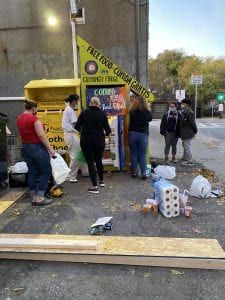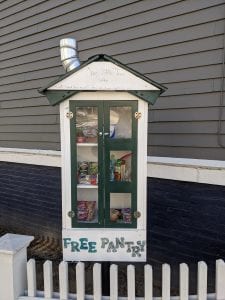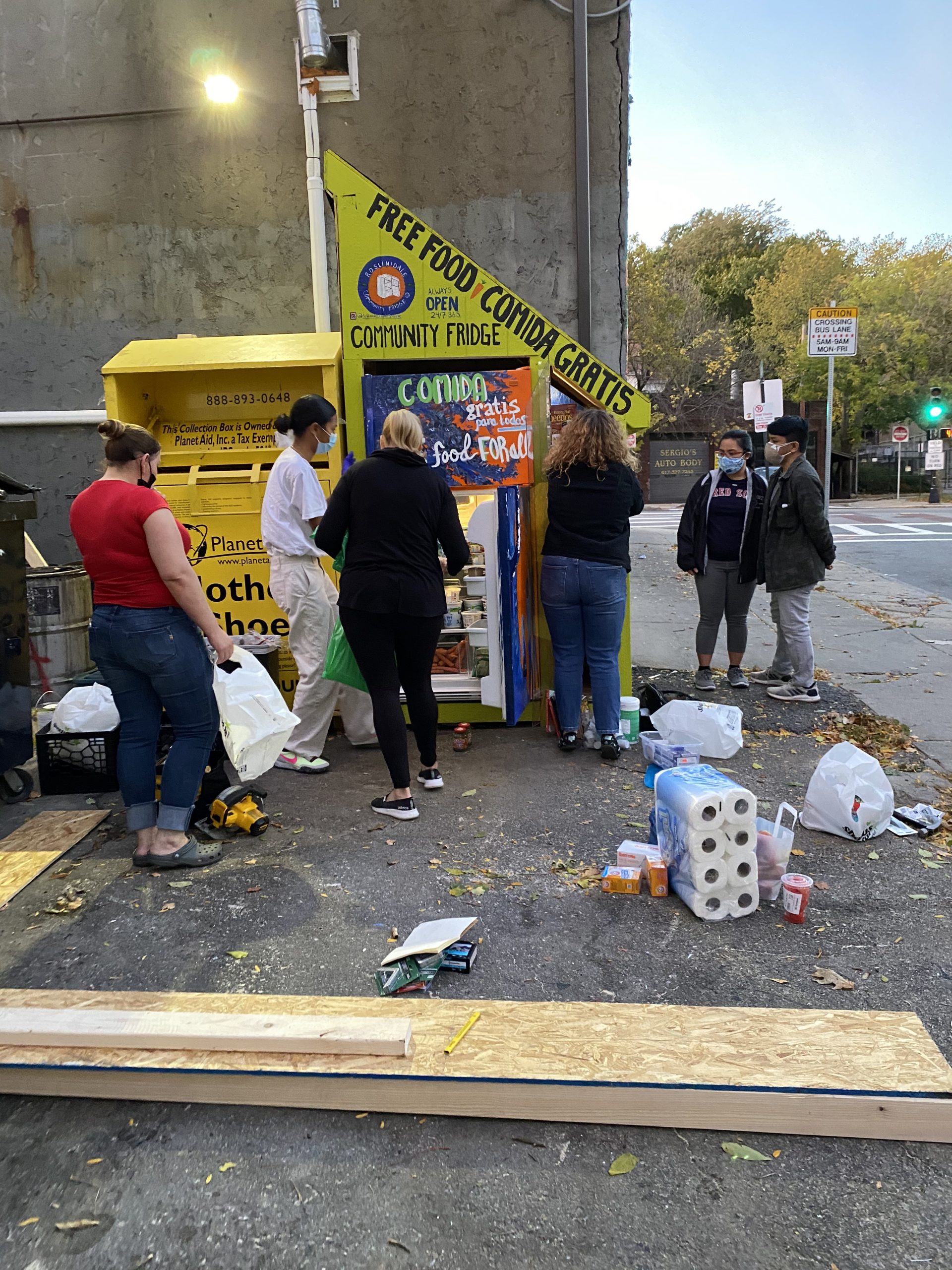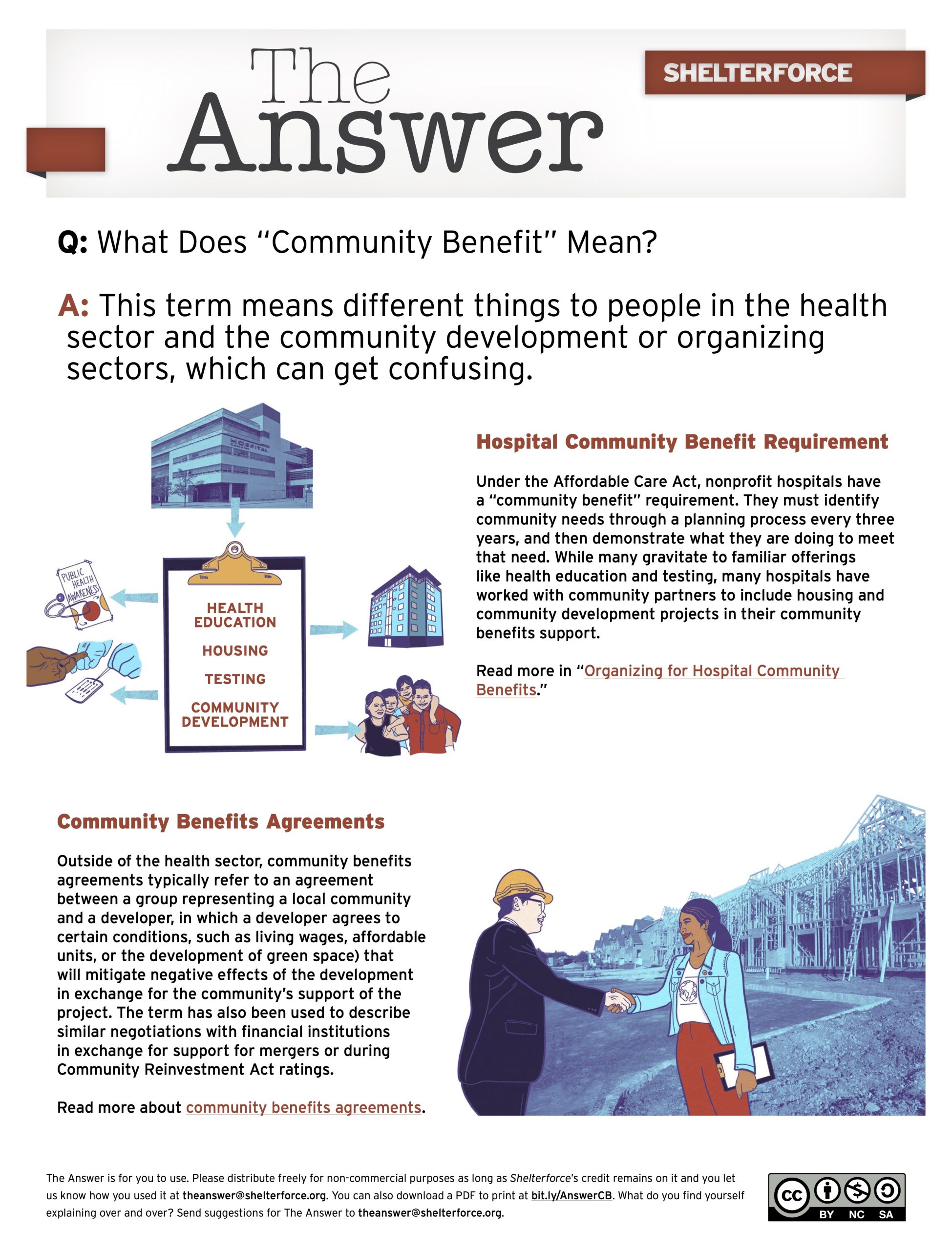
A community fridge in Boston. Photo courtesy of Meesh Zucker
You may have seen them in your own neighborhood, or on a walk in a bigger city—or maybe you’ve vaguely caught news of their existence somewhere online. It’s possible you’ve walked right past one without even knowing it—sometimes they’re hiding in plain sight, in that liminal space between the sidewalk and the houses.
I’m talking, of course, about community fridges (or their lower-tech cousins, free corner pantries). Like Little Free Libraries, but for food, these charming and quirky outposts in the war on hunger have popped up in neighborhoods across the country, in big cities like New York City, Detroit, and Los Angeles, to small and rural towns like Banner Elk, North Carolina, and Winslow, Arizona. According to a map of the “Freedge” network (“free” + “fridge”), there are more than 200 scattered community fridge sites across the U.S.; a similar number is reported on the catalog maintained by ChangeX, and an online map shows 100 community fridges in New York City alone (with new sites added every day). And being a pretty anarchistic innovation, many more unmapped locations are out there as well. The movement started slowly in Europe during the last decade and didn’t really catch on in the U.S. until 2019, but over this short time, the scrappy movement has resulted in a lot of food getting into the hands—and bellies—of hungry families.
The premise is simple: provide free food at convenient locations throughout the community and invite hungry people to help themselves: no strings attached, no questions asked. Refrigerators are typically located on private property, unlocked, sheltered from the elements, connected to power as necessary; some are pretty basic—just a cold box with food—while others can get pretty snazzy, tricked out with signs, fancy lights, or even paired with microwave ovens. Food is restocked by volunteer sponsors or nonprofit groups, or even in some cases by passersby. The safety of allowing this last aspect is questionable, and responsible fridge-stewards prevent it as they strive to deliver reliable, fresh, and healthy food; after all, spoiled milk in a fridge can be dangerous. Different cities have different rules about what’s allowed and what’s not (and what’s enforced and what’s not), and the whole ecosystem exists in something of a regulatory gray area, which can lead to additional concerns, frustrations, waste, and a certain degree of unreliability. Advocates are quick to emphasize the safeguards and strong ethical principles in place to prevent health and safety problems—and even cite academic studies to refute these concerns—but those familiar with challenge of keeping the office refrigerator or microwave clean remain skeptical.
That said, in sharp contrast with the culture of many public assistance programs, the overall ethos here is upbeat, friendly, informal, participatory, and decidedly unbureaucratic. While understandably and undeniably inefficient compared to larger-scale interventions, this new approach to a persistent problem may have broader implications for the ways we deliver services and how we envision our role in the community.
Just a Drop in the Bucket—But a Meaningful One
Food insecurity was a crisis before COVID-19 turned it into a tragedy, and it won’t be solved by these volunteer efforts alone. According to Feeding America, hunger affected more than 35 million people (including more than 10 million children) before the pandemic; the current estimate is closer to 50 million: nearly one in six Americans. More distressing projections point to the situation worsening before it gets better. To truly address hunger at this scale would require food banks the size of supermarkets and a distribution network comparable to Amazon’s, or at least a vastly expanded financial assistance programs (WIC, SNAP, and the like—which, to be fair, have been increased recently, as the current crisis grinds on). Better yet would be deep systemic changes to actually deliver living-wage jobs to all workers, together with the education, child care, transportation, and infrastructure needed to access these opportunities, as well as aid to those unable to find work. But for now, let’s not let the perfect be the enemy of the good.
Given these limitations, why, then, get excited about a patchwork quilt made of nothing more than brightly-colored hunger bandages—isn’t this just fiddling on the edges of starvation, a dangerous fad of palliative feel-goodery that distracts us from the real problem and redirects resources from real solutions? Not exactly, for a number of reasons.
For starters, although community fridges may not make a huge dent in the overall levels of food insecurity in the country, to hungry families every bit counts. A granola bar on the way to school may mean the difference between a kid thriving in class or dropping out; similarly, a steady supply of hard-to-come-by perishable items such as milk, eggs, or fresh produce (this is where the particular strength of the fridge really shines) can change a poor diet into a more balanced one, leading to healthy growth and stronger resistance to illness. And the ripple effects of these small differences play out over time and shape future patterns, affecting outcomes and mobility for a generation or more.
Equally important, the simplicity and openness of the system—no ID required, no sign-in—also means no stigma, no judgment, no fear of consequences. In the present context of increasing scrutiny on those seeking public benefits of any sort—and outright attempts to frighten vulnerable populations away from the resources—the anonymity provided by the model is commendable, and worth emulating in other policy areas wherever possible. Public parks provide a good example of this approach—and some libraries are following suit as well —but a truly “great society” should be capable and generous enough to offer so much more with an open and free hand: food, transportation, child care, health services, education, housing, needle exchange, and more. To paraphrase Dr. Martin Luther King Jr.’s reflections on the parable of the Good Samaritan, rather than worrying overmuch about real or imagined free-riders and cheats who might take assistance but not need it, we should worry more about those in our community who might need help but not get it.
Ironically, another benefit of this arrangement is that despite being anonymous, the transaction feels deeply personal: both donor and recipient understand that a human connection has been made, not just a transfer of goods. This spirit of friendship and community-building comes through loud and clear on the website of Atlanta’s “Free99Fridge” network:
“Free99Fridge locations are open 24/7/365 to all members of the community. Go to your nearest Free99Fridge and take what you need, friend. You do not need to be unhoused to utilize the fridges. All are welcome.”
The result—as evident in the growth and use of these networks, as well as the frequent and emphatic testimonials of participants—seems to be that the exchange improves attitudes on both sides, and people are more likely to both support and use these systems. One online guide specifically celebrates the importance of “bringing people together and building community” as a goal of the work. By emphasizing arms-length—but not remote—connections, community fridges seem to have discovered a sweet spot in service delivery: close enough to feel the warmth of shared humanity, but far enough to avoid a sense of resentment or burden.
Updating Our Picture of Hunger
Beyond these aspects, perhaps more important to the big picture, is exactly that: the picture these installations present to us. Efficiency concerns aside, seeing community fridges in our neighborhoods helps raise awareness of this “silent suffering”—hunger happens at home, behind closed doors, and can be pretty invisible in the broader community; these daily reminders—just outside the door, on the walk to work, where we wait for the bus with our kids—change our perceptions about the issue. For a generation that grew up viewing hunger as something “over there” (think of the TV ads for CARE, showing starvation-bloated bellies of African children a world away), there is a huge amount of relearning needed to appreciate that painful irony that while America may be the world’s breadbasket, hunger, malnutrition, and food insecurity have never been banished from these shores.

A little free pantry in Somerville, Massachusetts. Photo courtesy of Ezra Glenn
As with the more-common little libraries, a great deal of craft, care, and love goes into designing and building these unique, typically homemade installations: many are artistic masterpieces, creative (or funny) structures bedecked with brightly colored hippy-trippy artwork, sporting sappy slogans. The overall cheery nature of these designs helps from a PR perspective as well: through these sightings and interactions, we associate the fridges and pantries with helping and sharing, not hunger or deprivation.
In addition, by locating community fridges and free pantries on every corner, in every neighborhood, throughout all of our communities, we come to appreciate that not only is this an American problem, it may even be your own neighbors—not just people in some other town or distant region—who are suffering. Recognizing this may lead more people to heed the call and help increase the overall level of support we provide. That said, there is a big challenge of equity here: helping in your own neighborhood instead of across town or in a different part of the world may in fact exacerbate existing inequalities: but raising awareness can be like climbing a ladder, where each step leads you to a new perspective.
And so, without ignoring the severity of the problem and the need for much bolder solutions than a plucky, ragtag army of home-guard volunteer recruits fighting hunger in their own front yards, we can perhaps celebrate the spirit motivating these efforts and learn a bit from the amateurs about how to give and share: do so generously, with an open heart and a free spirit. Next time you see a day-glo orange fridge while you’re walking the dog, feel free to smile, snap a picture, and spread the good news—and perhaps tag on an added plea for more SNAP funding or deeper reform at the policy level as well.






Comments